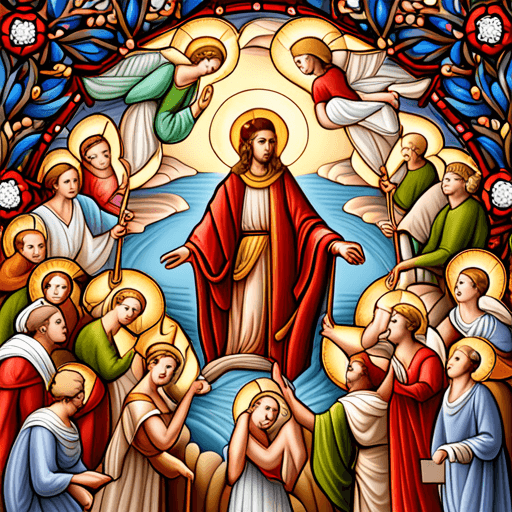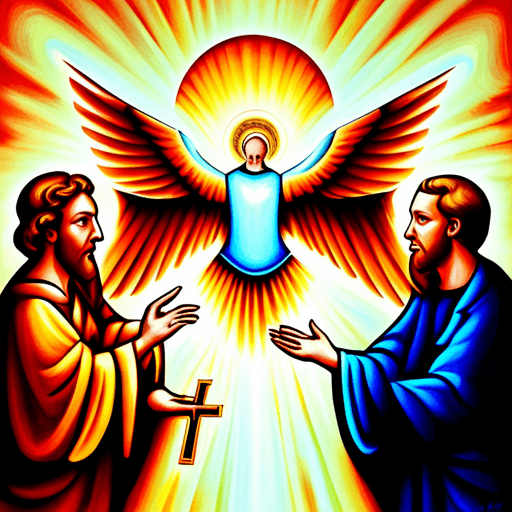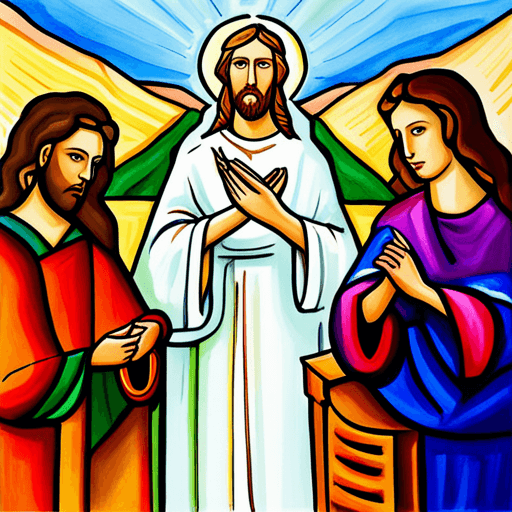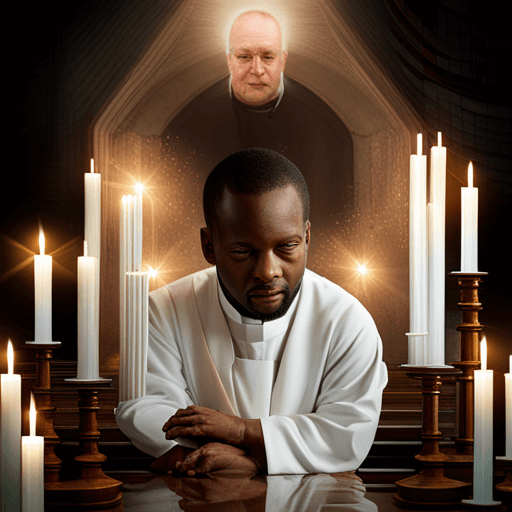Do you ever feel lost in this world, searching for meaning and connection? Look no further than the Fourteen Holy Helpers, a group of saints revered by Christians throughout history.
Each saint has their own unique symbol and story, providing guidance and protection to those who seek it. These holy helpers were believed to have miraculous powers that could heal the sick, protect from danger, and ward off evil spirits. They were often invoked during times of great need or desperation, offering hope and comfort to those seeking divine intervention.
Through their symbols and stories, they remind us of the power of faith and the interconnectedness of all things in this universe. Let us explore the symbolism behind some of these holy helpers and discover how they can guide us on our spiritual journey.
St. George and the Dragon: The Symbol of Courage and Protection
You’ll love learning about St. George and the Dragon! He’s the ultimate symbol of bravery and safety, slaying the dragon to protect his people.
St. George’s courageous story is one that has been told for centuries, inspiring countless individuals with its historical significance. As a Christian figure, St. George represents the triumph of good over evil and the courage to stand up against all odds.
His legend reminds us that we too can overcome our own dragons, whether they be physical or metaphorical obstacles in our lives. By channeling St. George’s strength and determination, we can find the courage to face any challenge that comes our way, confident in our ability to emerge victorious just as he did so long ago.
St. Blaise and the Woolen Comb: The Symbol of Throat Healing
St. Blaise’s miraculous woolen comb, which healed throats and protected against throat ailments, is a testament to the power of faith and divine intervention in times of physical suffering.
The history of St. Blaise’s woolen comb dates back to the 4th century, when he was imprisoned for his Christian beliefs. While in prison, a woman came to him with her son who had a fish bone stuck in his throat.
St. Blaise prayed over the boy and miraculously removed the bone from his throat with a woolen comb.
From that day on, St. Blaise became known as the patron saint of those suffering from throat illnesses and disorders.
A tradition developed where people would bring their sick children or animals to church on February 3rd (St. Blaise’s feast day), where priests would bless them using two crossed candles while holding a woolen comb between them as a symbol of St. Blaise’s healing powers.
Today, medical studies have shown that wool has natural anti-inflammatory properties, making it an effective tool for soothing sore throats and promoting healing – further adding weight to the claims made about St. Blaise’s miraculous woolen comb!
St. Christopher and the Christ Child: The Symbol of Safe Travel
If you’re planning a trip, it’s worth learning about St. Christopher and the Christ Child, who are believed to be protectors of safe travel.
The history of St. Christopher’s popularity dates back to the 3rd century. He was known as a giant who carried people across a dangerous river. Legend has it that one day, he carried a child who became heavier and heavier. Eventually, he realized that the child was actually Jesus Christ bearing the weight of the world on his shoulders.
The significance of the Christ Child in Christian iconography is immense. He represents innocence, purity, and salvation. His inclusion in St. Christopher’s story provides an added layer of protection during travel because it represents Jesus’ presence with us at all times.
Whether we believe in miracles or not, there is something comforting about knowing that we have someone watching over us during our journeys – someone who understands our struggles and wants us to arrive safely at our destination.
St. Barbara and the Tower: The Symbol of Protection from Lightning and Fire
Now, imagine you’re caught in a thunderstorm and need protection from lightning and fire – that’s where St. Barbara and the Tower come in.
St. Barbara was martyred for her Christian beliefs, but before she died, she prayed for protection against lightning and fire. It is said that after her death, a tower miraculously appeared to shelter those who prayed to her during storms.
The symbolism of the Tower of Babel reference also comes into play with St. Barbara and the Tower. The story of the Tower of Babel tells of people building a tower to reach heaven, but their pride led to confusion and chaos as they spoke different languages.
The tower became a symbol of human arrogance and sinfulness. However, with St. Barbara’s story, the tower becomes a symbol of divine protection and refuge from earthly dangers – like lightning strikes or fires caused by human error or negligence.
Through her martyrdom, St. Barbara reminds us that our faith can not only protect us spiritually but also physically in times of danger.
St. Vitus and the Rooster: The Symbol of Protection from Epilepsy and Anxiety
Protect yourself from epilepsy and anxiety with the help of St. Vitus and his trusty rooster companion. The story of St. Vitus dates back to the fourth century A.D., where he was known for healing those who suffered from epilepsy and other nervous disorders.
Legend has it that he was thrown into a pot of boiling oil by Emperor Diocletian, but miraculously emerged unscathed, thanks to his unwavering faith in God.
St. Vitus’ association with the rooster comes from an old superstition that epileptic seizures were caused by evil spirits entering the body through the mouth or nose while one slept. Roosters were believed to have the power to ward off these spirits by crowing at dawn, thus protecting people from seizures.
Today, St. Vitus is still venerated as a protector against epilepsy and anxiety, reminding us of our need for faith in times of uncertainty and fear. His historical significance may have faded over time, but his modern relevance remains strong as ever – reminding us that even in our darkest hours, we’re not alone on this journey called life.
Frequently Asked Questions
Who were the Fourteen Holy Helpers?
Do you know the story of the fourteen holy helpers? These saints were believed to have miraculous powers and were called upon during times of illness, danger, or other difficult situations.
Origin stories vary, but it’s said that they appeared in visions to a shepherd boy who was ill with the plague. The cultural impact of these holy helpers can still be felt today through churches and feast days dedicated to them.
But beyond their individual stories, the fourteen holy helpers serve as a reminder that we’re not alone in our struggles. As Christians, we believe in a community of saints who intercede for us and offer guidance on our journey towards salvation.
So when you feel lost or uncertain, remember that you’re part of something greater than yourself – a family bound by faith and love.
What is the historical significance of the Fourteen Holy Helpers?
Are you curious about the historical context and cultural impact of the fourteen holy helpers? These saints were revered in medieval times for their miraculous abilities to cure various ailments and protect people from harm.
Their popularity spread throughout Europe during times of war, famine, and epidemics, offering hope and comfort to those in need. The devotion to these saints also reflects a deep Christian philosophy that emphasizes intercession and the power of prayer.
Today, their legacy lives on through art, literature, and religious celebrations. By learning about these holy helpers, you can connect with a rich history of spiritual belief and find a sense of belonging within a larger community of believers.
What is the significance of the number fourteen in relation to the Fourteen Holy Helpers?
Are you curious about the significance of the number fourteen in relation to the fourteen holy helpers? Well, let me tell you that numerology plays a crucial role in understanding this concept.
The number fourteen represents completion and wholeness. It is said to have cultural interpretations as well, such as being associated with the lunar cycle or representing the number of stations on Christ’s journey to crucifixion.
As Christians, we believe that through these fourteen holy helpers, we can attain spiritual completeness and wholeness. Their intercession helps us overcome physical and mental afflictions.
So if you feel incomplete or lost, remember that there is a divine presence watching over us through these sacred helpers.
How did the Fourteen Holy Helpers become associated with specific symbols and illnesses?
Discover the origins of the symbolism associated with the fourteen holy helpers and how it has been influenced by various cultures throughout history.
Religious practices have long revered these saints, recognizing their miraculous abilities to heal specific illnesses.
As a result, each helper became associated with particular symbols that represented their unique powers.
For instance, Saint Barbara is often depicted holding a tower due to her ability to protect against lightning strikes.
Meanwhile, Saint Margaret is associated with childbirth as she miraculously survived being swallowed by a dragon while pregnant.
Delving into the symbolism of each of these helpers reveals not only their divine attributes but also our shared human experiences and desires for comfort and protection in times of need.
Are there any modern-day practices or traditions associated with the veneration of the Fourteen Holy Helpers?
As you honor and venerate the fourteen holy helpers, you may discover that their influence goes beyond healing specific illnesses.
Today, many devotees have reported modern-day miracles attributed to these holy saints. Some have claimed to experience miraculous healings from cancer or other life-threatening conditions by invoking the intercession of these powerful helpers.
Moreover, cultural adaptations have allowed for a deeper connection to these saints through religious art and music. By incorporating traditional symbols and songs into modern-day practices, we’re reminded of the timeless wisdom and guidance provided by these heavenly patrons.
As you continue your journey with the fourteen holy helpers, may their presence bring comfort and strength in times of need.
Conclusion
Congratulations! You’ve just taken a journey into the fascinating world of the Fourteen Holy Helpers and their powerful symbolism.
These saints are not only revered for their miraculous abilities to heal, protect, and guide us, but they also serve as an inspiration to live a life filled with courage and faith.
As you reflect on the stories of St. George’s fearlessness in facing the dragon or St. Blaise’s gentle touch in healing our throats, you can’t help but feel a sense of awe and wonder at these holy figures who have touched the lives of countless individuals throughout history.
They remind us that even in our darkest moments, we are never alone.
In closing, let us remember that these fourteen holy helpers are more than just symbols; they represent hope, love, and divine intervention in our lives.
As Christians, we can look to them as guides in navigating this unpredictable world with grace and humility.
May their stories inspire us to be compassionate towards others and faithful to God’s will.




